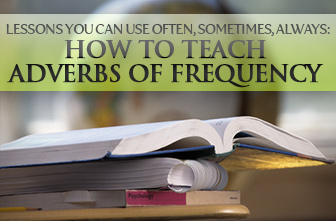Lessons You Can Use Often, Sometimes, Always: Teaching Adverbs of Frequency


Do you do your homework frequently or rarely? The frequency with which we do things is important. In fact, it can make all the difference in how others perceive us. So it’s important your students know how to express the frequency of actions, and that is just where adverbs of frequency and time expressions come into play. Here are eleven go to activities for practicing this language skill. Most are little to no prep, and all are effective. If you use them OFTEN you are sure to see language progress in your students.
On several small slips of paper, put adverbs of frequency (often, seldom, rarely, etc.) and time expressions (every day, once a week, etc.) and collect them in a hat. Have one student come to the front of the room and draw one. That person should ask a classmate a question to try and elicit the phrase on their slip of paper. For example, if the slip said twice a day, someone might ask, “How often do you brush your teeth?” The speaker has three chances to ask a question of three different classmates. If the person elicits the target response, they sit down. If not, they must draw another expression and try to elicit that one in three tries. If you like, have your students pull phrases one at a time or have the whole class go at once.
Have your students write five to ten statements about themselves, each using an adverb of frequency. Collect the papers and shuffle them. Then choose one list to read to your students. If a classmate is able to guess the author of the statements after you read only one from the sheet, he scores nine points. After two, eight points and so on. Keep playing until you read each person’s statements. Add up the scores and see who knows their classmates best.
This fun activity will get your students moving around the room while they ask their classmates questions. To prepare for the activity, draw a ladder on a piece of paper. It should have nine rungs each labeled with one of the adverbs of frequency in this order starting from the top: always, usually, frequently, often, sometimes, occasionally, seldom, rarely, never. Students start at the bottom of the ladder asking their classmates questions, trying to elicit a response from a classmate using the word never. For example, how often do you eat kimchi? If a person gets an answer with never, he can move up to the next run and try to elicit an answer with rarely from another classmate. Students must go from the bottom of the ladder to the top of the ladder, asking their classmates questions and getting answers with adverbs of frequency, without making a mistake. If they ever receive the wrong answer, they must go back to the start and the bottom rung of the ladder. Students are allowed to ask the same questions of the same people if they are knocked back down, however. See which student can get to the top of the ladder first.
Have students work with a partner for this speaking activity. One person makes a statement about how often their partner does something. For example, you rarely eat spaghetti. That person must then signal more often or less often (getting hotter, getting colder). The speaker changes the adverb of frequency in their statement until they get the answer correct. Students then switch roles. Continue the activity until each person has had several turns to make statements about his partner.
The activity starts with one person making a statement about herself using an adverb of frequency but not saying what the activity is. For example, someone might say, “I usually do this in the morning.” The other person must try and guess what the activity is, in this case take a shower. Each person should get three guesses at the activity. If he guesses correctly, he gets one point. Play until each person has had ten opportunities to guess at his partner’s activity. Whoever has the most points at the end of the game wins.
This is a simple print and go activity that starts with some fill in in the blank sentences. Print a copy of Adverbs of Frequency Guessing Game for each member of your class. Once students have the papers, give them a minute to fill in the blanks with adverbs of frequency. Then have each person work with a partner. Students take turns reading adverbs they used to fill in the blank. His partner must then guess which sentence he used that adverb to complete.
Two truths and a lie is a great go-to speaking and listening game for ESL students. In it, students write out three statements, two truths and one lie, about themselves. In this case, require students to use an adverb of frequency in each statement. They then have students take turns reading their statements to the rest of the class, who must then guess which statement is the lie. Your students will have a good time trying to stump their classmates, and everyone will get to know each other a little better.
In this activity, partners make statements about how often they do activities and their partner must agree with them. For example, one person might say, “I often watch soccer.” The other person MUST then agree saying something like, “I often watch soccer, too.” Then the second person makes a statement which the first person must agree with. If at any point someone thinks their partner is lying, they must state it. If they are correct that their partner is lying, they score point. If a person lies and their partner does not catch it, they score a point. Play until someone reaches five points.
For this fun and lively game, have students fill the spaces of a blank bingo board with adverbs of frequency and time expressions such as rarely, all the time, every week, twice a day, once a month, etc. On your go, students must mingle and talk to their classmates, trying to find an activity that both of them do with the same frequency. For example, if a person always wears underwear and they find another classmate who always wears underwear, they can both cross off the always square on their bingo board. When someone gets five squares in a row crossed of, they yell Bingo and win the game.
In this fun activity, students try and make predictions about how often their partners do certain activities. If you like, begin by brainstorming with your class some activities they might or might not do. Then put your students with a partner and have each person write ten sentences using some of the activities you brainstormed along with adverbs of frequency. Each person should write statements they think are true about their partners. After everyone has written their sentences, students compare what they wrote and score a point for every sentence that is true. The person with most correct sentences wins the round.
Most people would like to better themselves. It doesn’t have to be the first of the year for students to make resolutions to improve themselves and their lives. Have each person write out some plans for self-improvement using adverbs of frequency or time expressions in each statement. Have students list ten things they will do or not do and how often such as I will go to the gym every day. Ask volunteers to share some of their resolutions and discuss with the class how that activity could benefit someone trying to improve himself.